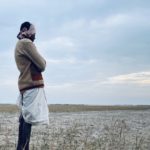Gujarat extends like two fingers into the great Arabian Sea as if reaching out to foreign lands. Over millennia, this coastal state has attracted Parsis, Arabs, and traders from Indonesia, Java and all over Asia. They thronged to Gujarat’s shores bringing in different foods, faiths and cultures– and taking (among other things) Gujarat’s ikat techniques to faraway lands.
On a map, the state looks like a lotus with three petals. In its textile traditions, it is a miniature of India, with great textile centres– Rajkot, Patan, Surat and Kutch– embracing astonishingly diverse traditions.
Think of any textile technique or form and you will find it in Gujarat. There are the brocades of ashavali, woven in Ridrol, that can compete with any Benarasi khinkhwab. At the other end of the spectrum are the coarse cotton weaves with counts as low as 10-count and 20-count cotton (according to the book, Saris of India by Rta Kapur Chishti), worn by peasants on a daily basis.
There is wool woven into shawls– called the dhabri and tangaliya– used by Rabari, Bharwad and Charan nomadic communities to protect against the harsh winters of the great Thar desert.
Kutch itself nourishes the many-layered block prints of ajrakh to the tie-dye bandini work to the weaves of Bhujodi, currently being woven in deshi or kala cotton.
Gujarat’s finest weave is undoubtedly the double ikat Patola weave of Patan, and now Rajkot. You have to imagine the entire saree before the yarn even touches the loom.
Luxury has many definitions, but all of them involve the hands. Well, in Gujarat, human hands have created a dazzling array of textiles and techniques. Enjoy their variety. Buy and support the handmade expertise exemplified by these weaves. Engender the virtuous cycle of craft patronage.
Welcome to our Gujarat edition! May your tribe increase!
Shoba Narayan
Founder & Anchor, Project LooM.





